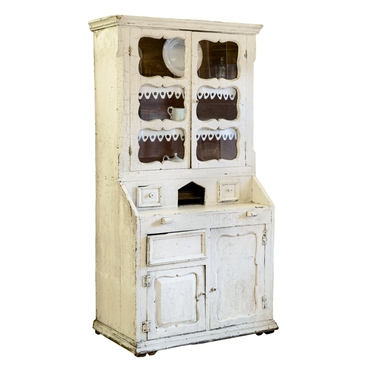The tradition of baking waffles appeared in Russia during the reign of Peter I (Peter the Great). The architects, artists, professionals of shipbuilding and mining fields came from abroad during that time. The Germans brought a recipe for a popular dessert, which replaced traditional Russian pryaniki (honey bread resembling gingerbread cookies).
A Russian word “vaflya” (“waffle”) derived from a German word “waffel”, which means “cell, honeycomb”. The name of this dessert was associated with its form and appearance. Its surface was covered with cells and looked like a honeycomb. However, later, the forms for baking waffles were of different patterns: with curls, floral ornaments, inscriptions, and even coats of arms.
The collection of Nizhnevartovsk Museum of Local History contains a double folding waffle iron with an ornament made in the form of a double-headed eagle. Its working parts are round, their diameter is about 12 cm. Long iron handles are attached to them. One of the handles ends with a small hook. Another one ends with a movable ring, which is thrown over a hook.
The waffle iron was made in the 19th century at the Kasli Ironworks. It was founded in the first half of the 18th century in the small town Kasli, which is located in the modern Chelyabinsk Region. At that time, the plant was famous for its art castings. The craftsmen made mantel clocks, writing sets, interior decorations in the form of animals and people. The plant also produced kitchen utensils — waffle irons, pans, pots.
A cast-iron waffle mold was heated over an open fire or coals. Then the dough was poured onto one half of a waffle iron, then, the waffle iron was closed and held for the time necessary to bake a waffle completely. This process took a lot of time because the waffles were cooked one by one. The cook had to be strong because the waffle iron was very heavy and required physical strength. That is why such a delicacy was not cooked very often — mainly on Sundays or holidays.
The waffle iron displayed at the museum exhibition previously belonged to the Dmitriev-Sadovnikov family, who lived in Tobolsk. In their hometown, they were famous because they learned to grow watermelons in the harsh Siberian climate. Probably, the second part of their surname (Russian “sad” is consonant with English “garden”) appeared as a nickname associated with their gardening experiments. Grigory Dmitriev-Sadovnikov, a famous local historian and explorer of the North, came from this family.
A Russian word “vaflya” (“waffle”) derived from a German word “waffel”, which means “cell, honeycomb”. The name of this dessert was associated with its form and appearance. Its surface was covered with cells and looked like a honeycomb. However, later, the forms for baking waffles were of different patterns: with curls, floral ornaments, inscriptions, and even coats of arms.
The collection of Nizhnevartovsk Museum of Local History contains a double folding waffle iron with an ornament made in the form of a double-headed eagle. Its working parts are round, their diameter is about 12 cm. Long iron handles are attached to them. One of the handles ends with a small hook. Another one ends with a movable ring, which is thrown over a hook.
The waffle iron was made in the 19th century at the Kasli Ironworks. It was founded in the first half of the 18th century in the small town Kasli, which is located in the modern Chelyabinsk Region. At that time, the plant was famous for its art castings. The craftsmen made mantel clocks, writing sets, interior decorations in the form of animals and people. The plant also produced kitchen utensils — waffle irons, pans, pots.
A cast-iron waffle mold was heated over an open fire or coals. Then the dough was poured onto one half of a waffle iron, then, the waffle iron was closed and held for the time necessary to bake a waffle completely. This process took a lot of time because the waffles were cooked one by one. The cook had to be strong because the waffle iron was very heavy and required physical strength. That is why such a delicacy was not cooked very often — mainly on Sundays or holidays.
The waffle iron displayed at the museum exhibition previously belonged to the Dmitriev-Sadovnikov family, who lived in Tobolsk. In their hometown, they were famous because they learned to grow watermelons in the harsh Siberian climate. Probably, the second part of their surname (Russian “sad” is consonant with English “garden”) appeared as a nickname associated with their gardening experiments. Grigory Dmitriev-Sadovnikov, a famous local historian and explorer of the North, came from this family.



